2023 estimated population = 302,296 (United States Census Bureau)
Greensboro's beginnings
Greensboro, the county seat of Guilford County and presently North Carolina’s third-largest city, was founded in 1808.
Guilford County’s establishment pre-dates that of Greensboro by nearly four decades (the county was constituted from parts of Rowan and Orange counties in 1771), and its early settlers were chiefly Scotch-Irish, Quakers, and Germans. The county seat was first at Martinville, located in the northwest part of the county. However, by the beginning of the 19th century, many county residents found the courthouse’s location inconvenient and wanted it moved to a central spot.
In 1807 the General Assembly passed an act appointing commissioners to find a suitable place for the county seat. Surveyors identified a swampy area in Greensboro’s present Fisher Park neighborhood as the county’s center, but the new county seat was established on nearby higher ground, now in the downtown area, on a 42-acre woodland tract which Ralph Gorrell sold to the commissioners for $98. Forty-four building lots were sold at public auction to raise money for building the courthouse and jail. The tiny village, extending only two blocks in each direction from the courthouse square, was named for General Nathanael Greene, who led the American forces at the Battle of Guilford Courthouse.
Antebellum through Reconstruction
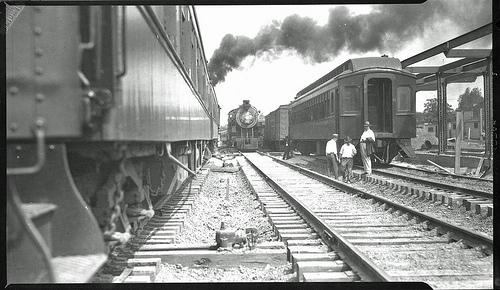
For most of the Antebellum period, Greensboro could perhaps be best described as just another sleepy courthouse town, not unlike many others in North Carolina, although it did become the home of the state’s first steam-powered cotton mill, the Mount Hecla Mill.
Railroad transportation began to change this. Greensboro owes its present-day image as the “Gate City,” and thus as a major thoroughfare in commerce, largely to the efforts of former governor John Motley Morehead and other prominent Greensboro men who successfully lobbied the State Legislature in 1849 to direct the route of the North Carolina Railroad, which would connect Goldsboro to Charlotte, northward through the city. This railroad was completed by 1856, and by the end of the 1800s several other rail lines either passed through or originated there.
At the time of the Civil War, Greensboro had a population of about 2,000. Local men, including forty-five members of the Guilford Grays, a local military unit, served in the Confederate Army. Although there were no battles in Greensboro, about 90,000 people were in the area during the last days of the war. These included refugees from the battle zones in eastern North Carolina, wounded soldiers arriving by train for care in makeshift hospitals, and Confederate and Union troops. (The Confederate officers received their paroles in Greensboro.) Confederate president Jefferson Davis and his cabinet arrived in Greensboro by train on their retreat from Richmond after Robert E. Lee’s surrender to Ulysses S. Grant.
During the Reconstruction period, Warnersville, a thriving community of recently-freed formerly enslaved people, was founded in Greensboro. This was accomplished with assistance from the Association of Friends of Philadelphia, which purchased land that was in turn sold to blacks who wanted to build homes for themselves and their families. Particularly instrumental in the community’s establishment was Yardley Warner, the prominent Pennsylvania Quaker for whom it was named. Local African Americans, who otherwise struggled against oppressive racism during the late 19th and early 20th centuries, found support in the presence of nearby Bennett College and of Warnersville’s vibrant merchant and professional classes. Many early Warnersville residents were buried in nearby Union Cemetery, which was placed on the National Register of Historic Places in 1993.
Growing up in Greensboro during the Civil War and post-War years was the famous short story writer William Sydney Porter (1862-1910), better known by his pen name of O. Henry. Cartoons that young Porter drew of local personalities who patronized his uncle’s drug store—for example, Judge Albion Tourgee, who later authored a best-selling novel on his Reconstruction experiences called A Fool’s Errand, by One of the Fools (1879)—are now featured in the exhibits at the Greensboro Historical Museum.
In 1870, the North Carolina General Assembly passed legislation, adopted by Greensboro voters, making the town a city. The new city was at this time only one mile square, with 2,000 residents.
Industry
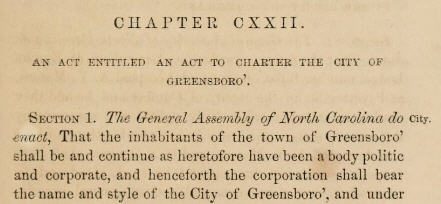
The pace of growth in manufacturing increased as Greensboro rebounded from the effects of the Civil War. These businesses included metal foundries, lumber and furniture plants, tobacco factories, and more. Many African Americans worked at a spoke and handle factory started by a former Union officer named Thomas McMahan, and the famous Vick Chemical Company (of Vicks VapoRub fame) began when Lunsford Richardson developed the famous cold remedy in his drug store in the 1890s. By 1891, Greensboro had sixteen manufacturing plants, and 60 trains came and went each day.
Developments in the textile industry at the close of the 19th century had the most long-lasting and important economic impact in this period. Moses and Ceasar Cone made their way to Greensboro in the early 1890s to fill a niche as selling agents for southern cotton mills. They soon expanded their enterprise to include mills of their own, completing their first Greensboro plant in 1896. By the mid-20th century, Cone Mills Corporation included twenty facilities throughout the South. Local Cone plants with names like Revolution and Proximity, employing thousands of people, had become anchors of Greensboro’s economy as well as an important part of its social history.
Higher education
Higher education has also long been an important part of Greensboro life. In 1837, Quakers founded New Garden Boarding School, the state’s first co-educational school, which became Guilford College in 1888. In 1838 Methodists obtained the first North Carolina state charter for a woman’s college, now Greensboro College. Bennett College, founded to educate African-Americans, followed in 1873. In 1891, the state colleges which would later become the University of North Carolina at Greensboro (UNCG) and North Carolina Agricultural and Technical University (NC A&T) were chartered. The institution which is now Guilford Technical Community College joined these colleges and universities in 1958, and Elon University School of Law opened in downtown Greensboro in 2006.
Twentieth Century
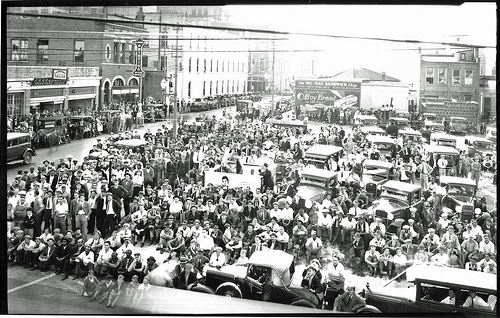
By the early 20th century, the Gate City had become one of North Carolina’s largest and most important cities, and the boom years of the 1920s saw rapid growth. In 1923, Greensboro annexed enough property to increase its size to almost eighteen square miles and over 45,000 people, making Greensboro North Carolina’s third-largest city. The new 17-story Jefferson Building, then the tallest and largest office building in the South, dominated the Greensboro skyline. Insurance became a major industry as Jefferson Standard and Pilot Life grew. In 1927, the downtown area acquired a new railroad station, the Carolina Theatre and the King Cotton Hotel. An airport west of the city increased Greensboro’s strength as a transportation hub.
As elsewhere, times were hard in Greensboro during the Great Depression. Over 11% of the city’s residents required local emergency relief assistance in 1934. Economic disaster was compounded in 1936 when a tornado struck downtown, killing twelve people.
However, by the 1940s Greensboro, led by textile manufacturing, was bouncing back. Cone Mills had become the largest denim maker in the world, while Burlington Industries, which moved to Greensboro in the 1930s, became a world leader in rayon production, and Blue Bell emerged as America’s leading manufacturer of overalls. Sears’ regional catalog center opened during this decade.
During World War II, Greensboro contributed to the war effort by hosting a major Army Air Force base, the only army camp located entirely within a U.S. city, which opened in 1943. Later, it became known as the Overseas Replacement Depot (ORD) and processed military personnel going to overseas duty and, later, those leaving the service. The ORD, located in northeast Greensboro, greatly changed the city, bringing in over 300,000 members of the military during the war years.
The city’s growth increased dramatically following World War II. Although Greensboro continued to play a prominent role as a textile manufacturer, other industries also arrived, such as Western Electric (1951) and Lorillard Tobacco (1956). During the post-war period, the city annexed new areas, including the towns of Hamilton Lakes and Guilford College. Greensboro now had public housing complexes, a Coliseum, a new airport, and Moses Cone Hospital. New shopping centers began to draw shoppers away from the downtown area. In 1949, WFMY became the first North Carolina television station to transmit live broadcasts, providing excellent reception throughout the area and as far away as Blowing Rock. The completion in 1972 of Wendover Avenue, one of the most expensive road projects in the state’s history, speeded up travel from one part of the city to another.
With a polio epidemic raging, the Greensboro community, in an outstanding example of cooperation, rallied to finance and build a polio hospital, which opened in 1948. Known to most as simply the "Polio Hospital," Central Carolina Convalescent Hospital operated as such until 1958 when it became the Central Carolina Rehabilitation Hospital. A polio hospital had become unnecessary because the Salk vaccine had ended the epidemic.
Issues of diversity and race also came to the fore in the years after the Second World War. In 1949, Greensboro elected Juliette Dwigins, its first woman, to city council, followed by Dr. William Hampton, the first African-American, in 1951 (although a black mayor would not come until 2007 with the election of Yvonne Johnson). But of course, it is for the lunch-counter sit-in that Greensboro’s vital role in the Civil Rights Movement is best remembered.
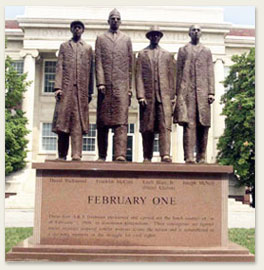
On February 1, 1960, four male North Carolina A & T students, after purchasing some items at the F. W. Woolworth store in Greensboro’s downtown area, sat at the store’s lunch counter and placed an order. The store refused to serve them. Many additional students joined the original four men, and the movement progressed to the nearby Kress store on April 21. Sit-ins and negotiations continued until July 25, when the lunch counters at Woolworth’s and Kress were finally opened to all races. While the Woolworth sit-in was not the first in the United States, it was the first to begin a widespread movement; eventually 54 cities in nine states had similar sit-ins. The Woolworth Building became the International Civil Rights Center & Museum in 2010.
Equitable medical care for African Americans was also a concern. In the early 1960s, local hospitals either refused black patients or accepted only those being transferred from the city’s hospital for blacks when that facility could not successfully treat them. In 1964, however, Greensboro’s hospitals became integrated, due largely to the efforts of George Simkins in bringing about a lawsuit (Simpkins v. Moses H. Cone Memorial Hospital) which went to the Supreme Court.
In the aftermath of Brown vs. the Board of Education, school desegregation was also a contentious matter. Although a few African American students attended formerly white schools as early as the late 1950s (Greensboro was the first city in the Southeast to desegregate a public school), full integration of the public schools did not occur until 1971.
Greensboro has long been haunted by a tragic incident, often referred to as the Greensboro Massacre, which stunned city residents and made national headlines on November 3, 1979. Members of a Communist organization which had been working to strengthen local unions met for a “Death to the Klan” parade. Klansmen and Nazis arrived and, within 88 seconds, their gunfire killed four of the activists and wounded ten others. A fifth member of the Communist group died the next day. Juries twice acquitted the Klan and Nazi members of all criminal charges. In recent years, a Truth and Reconciliation Commission—based on a South African model—has tried to help the city come to terms with this tragedy.
An important development in the city’s history has been the influx of numerous refugees and other immigrants. In the late 1970s and early ‘80s, many arrived from southeastern Asia; in the late 1980s and the 1990s, numbers of West Africans and Latinos moved into the Greensboro area. Currently, the members of these groups speak at least 118 languages, and an estimate is that 65,000 refugees and immigrants live in greater Greensboro, which includes the city plus the rest of Guilford County except for High Point.
Twenty-first Century
Although issues of race can still monopolize local attention (for example, when Greensboro’s police chief resigned in 2006 over allegations of discrimination against black officers), more recently jobs and the economy have been the center of attention, as manufacturing is no longer the economic bulwark that it once was. By the early 1980s, for instance, Cone Mills had closed its Revolution Mill and textiles were beginning their decline—in 2003, the company filed for Chapter 11 bankruptcy.
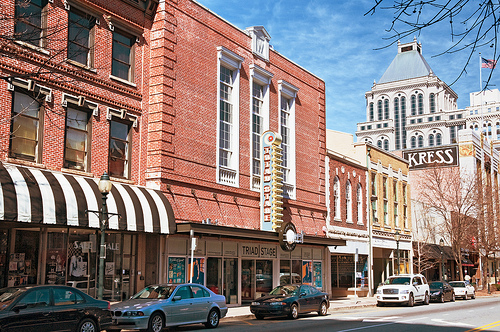
However, 21st -century Greensboro has long since ceased to be a city whose economic base depended disproportionately upon manufacturing. Although Greensboro still has successful manufacturers such as VF Corporation, RF Micro Devices, Honda Aircraft Company and Lorillard Tobacco, as well as large financial institutions such as United Guaranty and Lincoln Financial Group, in 2011 the chief employers are education, government, and health services.
Although Greensboro was the last major North Carolina city to adopt a district plan, in 1982 the city council voted for a district system for elections, ensuring that voters from all parts of town would be fairly represented.
The downtown area, which had suffered since the 1950s from the move of major stores to shopping centers, has undergone revitalization in recent years, and the city anticipates further redevelopment of downtown, with more and more residents embracing the “new-urbanism” concept and opting to live closer to downtown in “walkable” neighborhoods. The city also aspires to use greenways to completely encircle the city, fostering “walkability” and connectedness within and between neighborhoods.
John Motley Morehead’s mid-19th century vision of Greensboro as a transportation hub—the “Gate City” concept—still serves it well. A FedEx hub at Piedmont Triad International Airport was built with the intention of employing 1500 people. It opened in 2009 with far fewer employees than initially speculated due to the economic slow down of the time. It is anticipated that the FedEx hub will grow to meet its original goal when the economy recovers. Should this occur, the hub will bring with it job opportunities, an improved tax base, and a higher quality of life for Greensboro residents.